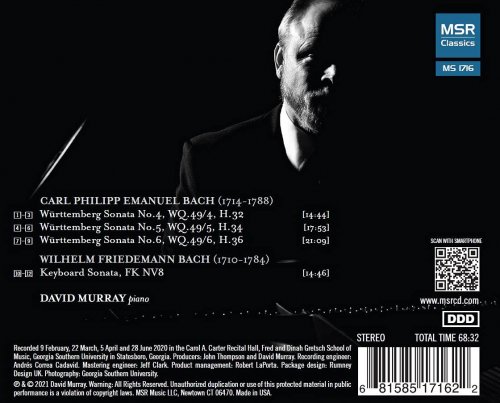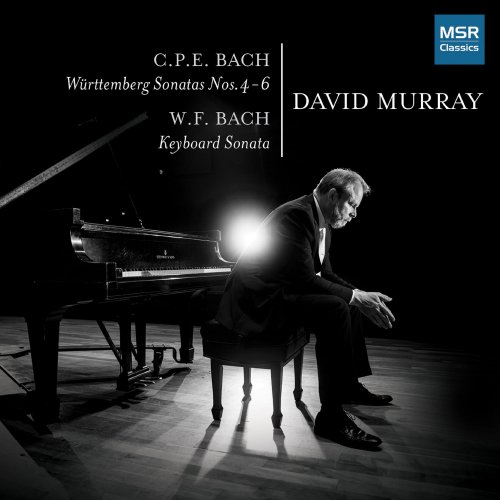
David Murray - C.P.E. Bach: Württemberg Sonatas Nos.4-6; W.F. Bach: Keyboard Sonata (2021)
BAND/ARTIST: David Murray
- Title: C.P.E. Bach: Württemberg Sonatas Nos.4-6; W.F. Bach: Keyboard Sonata
- Year Of Release: 2021
- Label: MSR Classics
- Genre: Classical
- Quality: FLAC (tracks)
- Total Time: 68:32 min
- Total Size: 263 MB
- WebSite: Album Preview

Tracklist:
1. Württemberg Sonata No. 4 in B:Flat Major, WQ. 49:4, H. 32: I. Un poco allegro
2. Württemberg Sonata No. 4 in B:Flat Major, WQ. 49:4, H. 32: II. Andante
3. Württemberg Sonata No. 4 in B:Flat Major, WQ. 49:4, H. 32: III. Allegro
4. Württemberg Sonata No. 5 in E:Flat Major, WQ. 49:5, H. 34: I. Allegro
5. Württemberg Sonata No. 5 in E:Flat Major, WQ. 49:5, H. 34: II. Adagio
6. Württemberg Sonata No. 5 in E:Flat Major, WQ. 49:5, H. 34: III. Allegro assai
7. Württemberg Sonata No. 6 in B minor, WQ. 49:6, H. 36: I. Moderato
8. Württemberg Sonata No. 6 in B minor, WQ. 49:6, H. 36: II. Adagio non molto
9. Württemberg Sonata No. 6 in B minor, WQ. 49:6, H. 36: III. Allegro
10. Keyboard Sonata in A Minor, FK NV8: I. Poco allegro
11. Keyboard Sonata in A Minor, FK NV8: II. Largo
12. Keyboard Sonata in A Minor, FK NV8: III. Presto
At some point in the late 1990s I had a life-changing musical experience: I came across Glenn Gould’s recording of Carl Philip Emanuel Bach’s A minor Württemberg Sonata and decided to listen to it. I must admit that my expectations were not high (after all, just how good could it be if I had never heard it?). To my surprise, for the next 15 minutes I stood rooted to the spot. By the time Gould played the opening bars of the third movement I had been converted.
This came as a great surprise to me. At the time, my only exposure to the music of C.P.E. Bach was the often-taught Solfeggietto (surely part of the reason for my youthful disdain), and my perception to this day is that his sonatas and other pieces are heard only infrequently. This is a great departure from his lifetime, when the name Bach typically referred to Emanuel rather than Sebastian and C.P.E. was admired by all the great composers of his day, including Haydn, Mozart, and Beethoven. At some point during the 19th century his name undeservedly fell into disrepute, with no less a personage than Schumann stating, “As a creative musician, [C.P.E.] remained very far behind his father.”
A posthumous comparison of the two Bach composers unfairly diminishes C.P.E.’s achievements as a composer. Rather than retread the same musical ground as his father’s generation, C.P.E. was one of the first composers to compose keyboard music with a wide emotional range. He was, aesthetically, what we would call a Romantic long before the dawn of the 19th century, making his subsequent neglect by composers of that era a mystery. As a result of this indifference, C.P.E. and his keyboard works slipped between the cracks of music history.
Long before the Romantic generation, C.P.E. composed a set of sonatas that helped to establish his reputation as a keyboard composer: the Württemberg sonatas. Composed between 1742 and 1744 and dedicated to his pupil Carl Eugen, the Duke of Württemberg, the six sonatas are challenging works that present the performer with a multitude of interpretative difficulties. C.P.E. gives full rein to his creative abilities in these works, manipulating rhythm, pacing, expression, forms and imitations of orchestral and chamber music. Each sonata consists of three-movements that are organized along similar lines.
Only a single copy of Wilhelm Friedemann Bach’s Keyboard Sonata in A minor survives, and the work itself has yet to be published. This is, to put it mildly, undeserved, for this sonata contains music of unusual power and expression. The first movement is an especially unique piece in and of itself, with a mystical quality that brings to mind the quasi-spiritual nature of Beethoven’s late works. The movement doesn’t conform to any standard form and instead sounds almost like a written-out improvisation (it is sectional and could be compared to a rondo but the character of the piece is as unlike that of a standard rondo as can be). The second, slow movement is brief and gestural; it feels almost like the musical version of having a conversation with oneself. The third movement is a tour-de-force perpetual motion finale that is somewhat similar in structure―although greatly expanded―to the sonatas of Scarlatti’s sonatas (even though it is unlikely that W.F. Bach knew the works of the Italian master). This recording is only the second of this compelling sonata, and is the world premiere recording on piano.
This came as a great surprise to me. At the time, my only exposure to the music of C.P.E. Bach was the often-taught Solfeggietto (surely part of the reason for my youthful disdain), and my perception to this day is that his sonatas and other pieces are heard only infrequently. This is a great departure from his lifetime, when the name Bach typically referred to Emanuel rather than Sebastian and C.P.E. was admired by all the great composers of his day, including Haydn, Mozart, and Beethoven. At some point during the 19th century his name undeservedly fell into disrepute, with no less a personage than Schumann stating, “As a creative musician, [C.P.E.] remained very far behind his father.”
A posthumous comparison of the two Bach composers unfairly diminishes C.P.E.’s achievements as a composer. Rather than retread the same musical ground as his father’s generation, C.P.E. was one of the first composers to compose keyboard music with a wide emotional range. He was, aesthetically, what we would call a Romantic long before the dawn of the 19th century, making his subsequent neglect by composers of that era a mystery. As a result of this indifference, C.P.E. and his keyboard works slipped between the cracks of music history.
Long before the Romantic generation, C.P.E. composed a set of sonatas that helped to establish his reputation as a keyboard composer: the Württemberg sonatas. Composed between 1742 and 1744 and dedicated to his pupil Carl Eugen, the Duke of Württemberg, the six sonatas are challenging works that present the performer with a multitude of interpretative difficulties. C.P.E. gives full rein to his creative abilities in these works, manipulating rhythm, pacing, expression, forms and imitations of orchestral and chamber music. Each sonata consists of three-movements that are organized along similar lines.
Only a single copy of Wilhelm Friedemann Bach’s Keyboard Sonata in A minor survives, and the work itself has yet to be published. This is, to put it mildly, undeserved, for this sonata contains music of unusual power and expression. The first movement is an especially unique piece in and of itself, with a mystical quality that brings to mind the quasi-spiritual nature of Beethoven’s late works. The movement doesn’t conform to any standard form and instead sounds almost like a written-out improvisation (it is sectional and could be compared to a rondo but the character of the piece is as unlike that of a standard rondo as can be). The second, slow movement is brief and gestural; it feels almost like the musical version of having a conversation with oneself. The third movement is a tour-de-force perpetual motion finale that is somewhat similar in structure―although greatly expanded―to the sonatas of Scarlatti’s sonatas (even though it is unlikely that W.F. Bach knew the works of the Italian master). This recording is only the second of this compelling sonata, and is the world premiere recording on piano.
Year 2021 | Classical | FLAC / APE
As a ISRA.CLOUD's PREMIUM member you will have the following benefits:
- Unlimited high speed downloads
- Download directly without waiting time
- Unlimited parallel downloads
- Support for download accelerators
- No advertising
- Resume broken downloads


